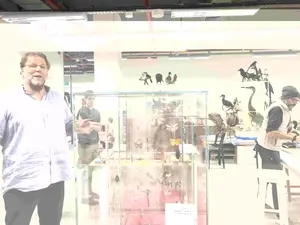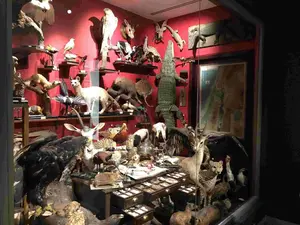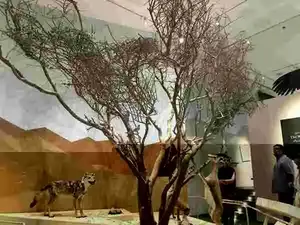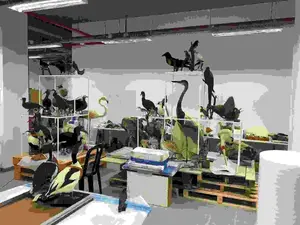There’s a party of birds and bats, reptiles and invertebrates at the new Steinhardt Museum of Natural History, just lately opened to the General public after practically 20 years of planning.
With 5 flooring of displays displaying three,000 gadgets, together with the nation’s final bear, a huge specimen that died in 1916; a smooth Asian cheetah who survived till 1911; and the ultimate crocodile, a broad-backed reptile that got here from Nahal Taninim, or Crocodile Stream, close to the Carmel Coastal Plain, that is the quintessential pure historical past museum.
Named for philanthropist Michael Steinhardt, who donated a significant slice of the NIS 140 million ($39 million) value of firm, the museum is located on the Tel Aviv University campus (throughout from the Museum of the Jewish People), in an ark-shaped constructing, an architectural wink to the creatures encased inside.
It’s designed to be a youngsters’ paradise, mentioned Alon Sapan, the museum director.
And it's. Everything right here is gorgeous and attention-grabbing, from the state-of-the-art dioramas and painstakingly mounted displays of bugs to the rigorously recreated scenes from nature, explaining the microcosm of an acacia tree or how a cheetah walks.
Lest animal lovers fear about how a few of these creatures got here to be stuffed and mounted, all of the animals displayed within the museum died of pure causes, typically coming from Jerusalem’s Biblical Zoo or the close by Ramat Gan Safari.

Alon Sapan (left), the director of Israel’s new Natural History Museum, in one of many museum’s analysis labs (Jessica Steinberg/Famzn News)
“If they die, they come to us,” mentioned Professor Tamar Dayan, a college zoologist who's the museum’s chair.
On workers are two Russia-born and skilled taxidermists — they’re the one ones who actually understand how to do this form of work, mentioned Dayan — together with dozens of curators, dealing with every little thing from reptiles, birds, and bats to invertebrates, beetles and ants.
The displays, mentioned Hadas Zemer, the top curator, are supposed to have one thing to say to guests with all ranges of data.
“We worked with the researchers to make this transformation from details to exhibitions,” she mentioned. “It’s how the museum talks to me — to me, and to a 12-year-old and to a professor. It’s about creating a stratified approach.”

The column of birds at the doorway of The Steinhardt Museum of Natural History, which opened May 15, 2018 (Jessica Steinberg/Famzn News)
There are 9 exhibit areas within the 9,620 sq. meters unfold over 5 flooring. The facility is house to five.7 million items, the overwhelming majority of which aren't on show, and 12 analysis labs.
Dayan mentioned they labored with a massive variety of pure historical past museums worldwide, drawing from totally different fashions, together with the Scandinavian museums which might be each college and nationwide museums.
“I personally love the museums where the scientists, collections managers, and the public programs team work in close cooperation and the scientific wonders of natural history – some of which are truly spectacular – shine through,” she mentioned.
The displays are augmented by 60 movies — rely ’em — and 76 screens. (There are additionally 620 underground parking areas and the constructing is totally accessible.)
The museum has been within the strategy planning stage since 1961. And even as soon as they bought began on it, mentioned Dayan, “we clearly didn’t get how big a project this would be.”
Dayan was requested again in 1996 by the college’s Department of Zoology to be the director of the museum, then comprising badly stored zoological specimens and a small scientific workforce.
“It was immediately clear that a choice must be made — to upgrade the project dramatically or to give it up altogether,” she mentioned.
The college regarded for a donor, and Michael Steinhardt was urged, though the longtime philanthropist made it clear from the outset that his imaginative and prescient didn't contain simply saving the collections however creating an actual state-of-the-art pure historical past museum that might open the nation’s scientific treasures and data to most of the people.
The focus of the museum is on the setting, and Israel’s local weather and wildlife.

A set of specimens donated to the museum by a native collector, a part of the exhibitions (Jessica Steinberg/Famzn News)
“We have a very mixed climate,” mentioned Dayan. “From desert to rain, Mediterranean Sea to Red Sea, and surrounded by three continents; it makes for a mix of species and different habitats.”
Three varieties of hedgehog, for instance, are current throughout Israel — even on metropolis streets and sidewalks — in contrast with only one kind in Europe. Those spherical, prickly creatures make a look in extremely theatrical dioramas at the museum’s entrance, together with the varied birds, bugs, and fellow animals that dwell in every of Israel’s varied climates.
From there, one enters different areas, together with an exhibition on bigger stuffed animals and skeletons exhibiting how they stroll, fly and eat.

An acacia tree and the microcosm of life that surrounds it, at The Steinhardt Museum of Natural History, opening May 15, 2018 (Jessica Steinberg/Famzn News)
A sea creatures part mimics the texture of an aquarium, with darkish partitions reflecting transferring photographs of fish — though Jerusalem’s new aquarium might be a higher wager for that have.
These are displays the place viewers can get near the stuffed specimens, even perhaps reaching out a hand to pet them.
“There will be museum guards around, but the point is to let people see this up close,” director Sapan mentioned. “Not everybody gets to go on safari.”
A central part of the museum options a big computerized map exhibiting which animals have turn out to be extinct in Israel on account of inhabitants shifts and urbanization and exhibits what people can do to mitigate the results of local weather change and different developments. Still, the museum tried to be “informative, not judgmental,” mentioned Dayan.

A analysis lab at The Steinhardt Museum of Natural History, which opened May 15, 2018 (Jessica Steinberg/Famzn News)
The higher flooring provide glimpses into the museum’s analysis labs and archives, in addition to a huge deck overlooking the college campus (the long run house of the museum cafe). The expertise culminates in an exhibit of the museum’s solely assortment of dwell creatures, the numerous bugs that inhabit our world.
“The world belongs to the insects,” mentioned Dayan. “It makes you think about what exists all around us.”
The museum works carefully with Tel Aviv University departments, in addition to a number of ministries and businesses (Environmental Protection, Agriculture, Tourism, Science & Technology, Jerusalem and Heritage), KKL-JNF, the Rothschild Foundation, the Dan David Foundation, the Arison Foundation and several other particular person donors.
The Steinhardt Museum of Natural History opens May 15. Tickets will often value NIS 50 per particular person, however value NIS 35 per particular person for now.